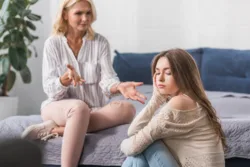What Is Cyberbullying and What Are Its Effects?

As social media becomes more and more prevalent in the lives of teens and children, cyberbullying becomes more of an issue. It’s estimated that 37 percent of people between the ages of 12 and 17 have been bullied online at some point.
But what is cyberbullying and what are its effects? In this article, we’ll answer these big questions:
- what is the definition of cyberbullying?
- What are examples of cyberbullying?
- What are the types of cyberbullying?
- How to stop cyberbullying?
Here’s what you need to know about this growing concern to keep your kids safe.
What is the definition of cyberbullying?
Cyberbullying is the use of electronic communication to bully a person. Cyberbullying generally includes messages of an intimidating or threatening nature that have a negative effect on an individual. Cyberbullying generally occurs over with the use of cell phones, computers and tablets.
Messages of bullying online can be private, such as via text messages or direct messages on apps, or they can be images and messages that are publicly viewable.
What are examples of cyberbullying?
Here are a few examples of cyberbullying so you can know what to look for if you think cyberbullying could be impacting your child.
- A direct message through a gaming platform reads, “you suck at this game. If we lose I’m gonna come to your house and hurt you”
- A post with an embarrassing photo from years ago of your child and a former friend playing dress up that was posted without her consent
- A series of text messages that have harmful messages, like “you’ll never amount to anything,” “you’re ugly and no one wants to date you,” “your family is poor so you can’t hang out with us,” etc
If you’ve noticed your child is acting strangely around devices and seems sad or withdrawn, you may want to look for or ask about messages like the ones above.
What are the types of cyberbullying?
In order to understand the nature and the harm of cyberbullying, it may be important to look at the 10 different types of cyberbullying that are generally found online.
1. Exclusion
The act of excluding someone can be a form of bullying. Although leaving someone out may be done by peers unintentionally, in the case of cyberbullying online platforms are often used to target or demonstrate how or why a person is left out.
2. Harassment
Harassment includes any form of cyberbullying that is repeated frequently. These messages can be threatening or harmful and are designed to inflict emotional harm.
3. Outing
Sharing sensitive information about someone online against their will is called outing. Outing is done with the purpose of embarrassing someone and may be initiated by a former close friend. The sensitive information may have been shared in confidence. A young person who feels left out may also try to share secrets as a way to make friends and have it backfire as ammo for cyberbullying.
4. Trickery
In this type of cyberbullying, outing is also involved, but it involves a bully who uses deception or manipulation to gain personal or sensitive information from the target.
5. Cyberstalking
Cyberstalking is one of the most serious forms of online bullying and is a criminal offense. It involves a person extending threats of physical harm to a child and can even extend to in-person stalking.
6. Fraping
Fraping is the process of using another person’s account to post inappropriate material. The material could be comments, images or links and can be damaging to a person’s reputation and embarrassing.
7. Masquerading
In an effort to remain anonymous, a bully will sometimes create an online profile pretending to be someone else or someone unknown from which to bully a victim. This could include fake social media accounts, phone numbers and emails. It can be difficult to trace down a cyberbully who operates under a false name.
8. Dissing
In the case of dissing, a bully would post false or cruel messages about a victim in order to destroy a relationship or a person’s reputation. This information is designed to emotionally harm the victim and cause disturbance in his or her social life.
9. Trolling
This type of bullying tends to be less personal and less common, but trolling occurs when a person posts inflammatory comments, videos or images online. They are rarely directed at an individual but may be directed at groups of people.
10. Flaming
Flaming is similar to trolling, but inflammatory comments are directed at or sent to an individual.
How to stop cyberbullying
If you are a parent of a victim of cyberbullying, it’s easy to feel helpless. It can be difficult to notice whether cyberbullying is occurring to your child if he or she keeps devices private or if the cyberbullying is happening on a school device or an app you don’t know about. Moreover, it can be difficult to track a cyberbully and you may not know what to do once you’ve found out.
Here are a few steps to follow once you’ve noticed that cyberbullying is affecting your child:
- Open the conversation with your child to talking about cyberbullying and the harm it can cause;
- Express your desire to help stop cyberbullying and that your child is safe
- Involve the school system by talking to a guidance counselor, whether or not you’re aware that the bully attends the same school
- Depending on whether serious threats of physical harm are involved, involve law enforcement
- Keep an open conversation with your child, and discourage the use of certain apps that tend to be the focus of a cyberbully
As a parent, you also have the important opportunity to involve your child in therapy or counseling. A trained mental health professional at the Light Program can help your child overcome mental distress caused by cyberbullying, reform positive relationships with peers and feel comfortable at school. Call The Light Program now.








